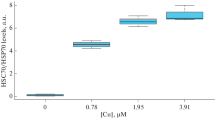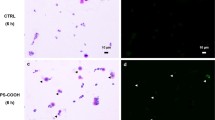Abstract
Oceans and seas are of paramount importance to the health of planet Earth and human kind. Marine ecosystems should be defended against attack of polluting agents by continuous monitoring; the means of such monitoring should be as green as possible, i.e. based on sensors manufactured by biocompatible and easily disposable raw materials. In this study, we lay the basis for the future development of biosensors of marine environment based on sea urchin cells cultured on nanoporous aluminium oxide. These cells are promising as in previous works they demonstrated high response to stressors, and the proposed substrates have low costs since fabricated by inexpensive anodization process from consumer quality aluminium foils. Coelomocytes of the Mediterranean sea urchin Paracentrotus lividus were cultured on the nanoporous alumina for up to 5 days in vitro. Then, a biochemical characterization was carried out, checking the cholinergic system pathway by means of serotonin autofluorescence induced by aldehyde exposure and by expression and functionality of neuroactive molecules, such as acetylcholinesterase and muscarinic acetylcholine receptors. Both living cell quality and system biochemistry were not affected after the culture, and both electrical modulation and non-self-reactivity were maintained. These findings suggest the possibility of using the sea urchin immune cells cultured on nanoporous alumina as tools for monitoring the marine water quality, based on their electrical response.
Graphic abstract







Similar content being viewed by others
References
7th Framework Programme—European Commission Project (2016) DEVOTES: DEVelopment of innovative tools for understanding marine biodiversity and assessing good environmental status
7th Framework Programme—European Commission Project (2018) EnviGuard—eevelopment of a biosensor technology for environmental monitoring and disease prevention in aquaculture ensuring food safety
Alijagic A, Pinsino A (2017) Probing safety of nanoparticles by outlining sea urchin sensing and signaling cascades. Ecotoxicol Environ Saf 144:416–421
Amemiya S (2001) Developmental modes and rudiment formation in sea urchin. In: Yokota Y, Matranga V, Smolenicka Z (eds) The sea urchin: from basic biology to aquaculture. Swets and Zeitinger, Lisse, pp 37–50
Angelini C et al (2004) Acetylcholine synthesis and possible functions during sea urchin development. Eur J Histochem 48(3):235–244
Anselmo HMR, Van Den Berg JHJ (2012) Inhibition of cellular efflux pumps involved in multi xenobiotic resistance (MXR) in echinoid larvae as a possible mode of action for increased ecotoxicological risk of mixtures. Ecotoxicology 21(8):2276–2287
Bean TP et al (2017) A review of the tools used for marine monitoring in the UK: combining historic and contemporary methods with modeling and socioeconomics to fulfill legislative needs and scientific ambitions. Front Mar Sci 4:263.1–263.29
Brüggemann D (2013) Nanoporous aluminium oxide membranes as cell interfaces. J Nanomater 2013:460870.1–460870.18
Canesi L et al (2005) Interactions between Mytilus haemocytes and different strains of Escherichia coli and Vibrio cholerae O1 El Tor: role of kinase-mediated signalling. Cell Microbiol 7:667–674
Danovaro R et al (2016) Implementing and innovating marine monitoring approaches for assessing marine environmental status. Front Mar Sci 3:1–25
Dan-Sohkawa M, Suzuki J, Towa S, Kaneko H (1993) A comparative study on the fusogenic nature of echinoderm and nonechinoderm phagocytes in vitro. J Exp Zool 267:67–75
de la Escosura-Muñiz A, Merkoçi A (2016) Nanochannels for electrical biosensing. Trends Anal Chem 79:134–150
Diaz-Rios M et al (2019) Serotonin modulates dendritic calcium influx in commissural interneurons in the mouse spinal locomotor network. J Neurophysiol 98:2157–2167
El Merhie A et al (2019) Neuronal-like response of N2a living cells to nanoporous patterns of thin supported anodic alumina. Colloids Surf B 178:32–37
Ellman GL et al (1961) A new and rapid colorimetric determination of acetylcholinesterase activity. Biochem Pharmacol 7(2):88–95
Falugi C, Aluigi MG (2012) Early appearance and possible functions of non-neuromuscular cholinesterase activities. Front Mol Neurosci 5:1–12
Falugi C et al (2012) Toxicity of metal oxide nanoparticles in immune cells of the sea urchin. Mar Environ Res 76:114–121
Felder CC et al (1995) Comparison of the pharmacology and signal transduction of the human cannabinoid CB1 and CB2 receptors. Mol Pharmacol 48(3):443–450
Furneaux R, Rigby W, Davidson A (1989) The formation of controlled-porosity membranes from anodically oxidized aluminium. Nature 337:147–149
Gambardella C et al (2015) Morphofunctional and biochemical markers of stress in sea urchin life stages exposed to engineered nanoparticles. Environ Toxicol 31:1–11
Gille J et al (2014) Marine sensors; the market, the trends and the value chain. In: 2014 IEEE sensor systems for a changing ocean (SSCO), pp 1–14
Giovannoni E, Fabietti G (2013) What is sustainability? A review of the concept and its applications. In: Busco C et al (eds) Integrated reporting: concepts and cases that redefine corporate accountability. Springer, Cham, pp 21–40
Glinski Z, Jarosz J (2000) Immune phenomena in echinoderms. Arch Immunol Ther Exp 48(3):189–193
Graham AHD et al (2009) Formation of a porous alumina electrode as a low-cost CMOS neuronal interface. Sens Actuators B Chem 138(1):296–303
Graham AHD et al (2010) Nanostructured electrodes for biocompatible CMOS integrated circuits. Sens Actuators B Chem 147(2):697–706
Ingham CJ, Ter Maat J, de Vos WM (2012) Where bio meets nano: the many uses for nanoporous aluminum oxide in biotechnology. Biotechnol Adv 30(5):1089–1099
Justino CIL et al (2015) Sensors and biosensors for monitoring marine contaminants. Trends Environ Anal Chem 6–7:21–30
Kapuscinski J (1995) DAPI: a DNA-specific fluorescent probe. Biotech Histochem 70(5):220–233
Karnovsky MJ, Roots L (1964) A “direct colouring” thiocholine method for cholinesterase. J Histochem Cytochem 12:219–221
Kröger S, Piletsky S, Turner APF (2002) Biosensors for marine pollution research, monitoring and control. Mar Pollut Bull 45(1–12):24–34
Kumeria T, Losic D (2011) Reflective interferometric gas sensing using nanoporous anodic aluminium oxide. Phys Status Solidi 408(10):406–408
Leal JKF et al (2017) Acetylcholinesterase provides new insights into red blood cell ageing in vivo and in vitro. Blood Transfus 15(3):232–238
Majeske AJ, Bayne CJ, Smith LC (2013) Aggregation of sea urchin phagocytes is augmented in vitro by lipopolysaccharide. PLoS ONE 8:61419
Matranga V et al (2000) Cellular and biochemical responses to environmental and experimentally induced stress in sea urchin coelomocytes. Cell Stress Chaperones 5:113–120
Matranga V, Bonaventura R, Di Bella G (2002) Hsp70 as a stress marker of sea urchin coelomocytes in short term cultures. Cell Mol Biol 48(4):345–349
Matranga V et al (2005) Monitoring chemical and physical stress using sea urchin immune cells. In: Matranga V (ed) Progress in molecular and subcellular biology, vol 39. Springer, Berlin, pp 85–110
Matranga V et al (2006) Impacts of UV-B radiation on short-term cultures of sea urchin coelomocytes. Mar Biol 149:25–34
Mills G, Fones G (2012) A review of in situ/IT methods and sensors for monitoring the marine environment. Sens Rev 32(1):17–28
Minganti A, Falugi C (1980) An epithelial localization of acetylcholinesterase in the ascidian Ciona intestinalis embryos and larvae. Acta Embryol Morphol Exp 1(2):143–155
Pinsino A, Alijagic A (2019) Sea urchin Paracentrotus lividus immune cells in culture: formulation of the appropriate harvesting and culture media and maintenance conditions. Biol Open 8:bio039289
Pinsino A, Matranga V (2015) Sea urchin immune cells as sentinels of environmental stress. Dev Comp Immunol 49:198–205
Pinsino A, Della Torre C, Sammarini V (2008) Sea urchin coelomocytes as a novel cellular biosensor of environmental stress: a field study in the Tremiti Island Marine Protected Area, Southern Adriatic Sea, Italy. Cell Biol Toxicol 24:541–552
Runge JM (2018) The metallurgy of anodizing aluminum—connecting science to practice. Springer, Berlin. https://doi.org/10.1007/978-3-319-72177-4
Russell WMS, Burch RL (1959) The principles of humane experimental technique. Methuen, London
Salerno M et al (2013) Adhesion and proliferation of osteoblast-like cells on anodic porous alumina substrates with different morphology. IEEE Trans Nanobiosci 12(2):106–111
Smith LC et al (2010) Echinoderm immunity. In: Söderhäll K (ed) Advances in experimental medicine and biology, vol 708. Springer, New York, pp 260–301
Smith LC et al (2018) Echinodermata: the complex immune system in echinoderms. Adv Comp Immunol. https://doi.org/10.1007/978-3-319-76768-0
Stępniowski WJ et al (2015) A comparative study of electrochemical barrier layer thinning for anodic aluminum oxide grown on technical purity aluminum. J Electroanal Chem 741:80–86
Toccafondi C et al (2014) Multifunctional substrates of thin porous alumina for cell biosensors. J Mater Sci Mater Med 25(10):2411–2420
Toccafondi C et al (2015) Biomedical applications of anodic porous alumina. Curr Nanosci 11(5):572–580
Toccafondi C et al (2016) Fabrication of gold-coated ultra-thin anodic porous alumina substrates for augmented SERS. Materials 9(6):403–414
Tsan M-F, Gao B (2009) Heat shock proteins and immune system. J Leukoc Biol 85(6):905–910
Wessler I, Kirkpatrick CJ (2008) Acetylcholine beyond neurons: the non-neuronal cholinergic system in humans. Br J Pharmacol 154:1558–1571
Acknowledgements
All the experimental activity was founded by Institutional Research Founds from University of Genoa, Genoa, Italy (FRA 2018–2019). The authors wish to thank all who contributed to the sea urchins collection.
Author information
Authors and Affiliations
Contributions
OP and CF contributed to conceptualization; OP, MS and CG provided resources; OP, CF, MS and CG provided the methodology; MS, MN, CF and CG performed the investigation; CG performed formal analysis; CG and OP contributed to visualization; CF was involved in writing—original draft preparation; CG, OP and MS was involved in writing—review and editing; OP and CF performed supervision and project administration.
Corresponding author
Ethics declarations
Conflict of interest
The authors declare no conflict of interest.
Ethical approval
All procedures performed in this study involving animals (sea urchin P. lividus) were in accordance with European ethical standards. The type of animals involved in this research is included in the Annex III of the Marine Strategy Framework Directive 2008/56/EC on the approximation of laws, regulation and administrative provisions regarding the protection of animals used for experimental and other scientific purposes. The regulation lays down what is commonly known as the 3Rs (Reduce, Refine and Replace) approach.
Additional information
Editorial responsibility: M. Abbaspour.
Rights and permissions
About this article
Cite this article
Gambardella, C., Falugi, C., Salerno, M. et al. Sea urchin coelomocytes cultured on nanoporous aluminium oxide as a potential tool for marine environmental monitoring. Int. J. Environ. Sci. Technol. 17, 2937–2948 (2020). https://doi.org/10.1007/s13762-020-02644-w
Received:
Revised:
Accepted:
Published:
Issue Date:
DOI: https://doi.org/10.1007/s13762-020-02644-w




